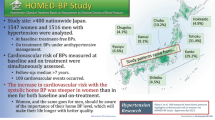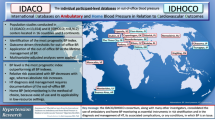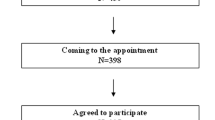Abstract
Objectives: The SHEAF study (Self measurement of blood pressure at Home in the Elderly: Assessment and Follow-up) is a 3-year prospective cohort study of French elderly (⩾60 years) hypertensive patients designed to assess whether home blood pressure (HBP) measurement provides additional prognostic information over office blood pressure (OBP) in terms of cardiovascular mortality and morbidity. The objective of the present work is to describe the baseline data of the population enrolled in the SHEAF study with special emphasis on blood pressure control in treated hypertensives.
Methods:During the 2-week initial inclusion phase, baseline demographics, cardiovascular risk factors, antihypertensive treatments as well as office and home blood pressure were recorded. Baseline OBP was assessed using a mercury sphygmomanometer (three consecutive measurements during two visits performed 2 weeks apart). HBP was performed over a 4-day period (three consecutive measurements in the morning and in the evening).
Results:A total of 4939 (95%) of the 5211 patients included in the SHEAF study were treated with at least one antihypertensive drug. Their ages ranged from 60 to 99 years (mean age 70 ± 7 years); 49% were men, 12% had a previous history of coronary artery disease, 14% diabetes and 43% a treated dyslipidaemia. A total of 45% of the treated patients received a single antihypertensive drug, 34% two drugs, 21% three drugs or more. Overall 23% of treated hypertensives were normalised at the doctor’s office (systolic BP <140 mm Hg and diastolic BP <90 mm Hg) and 27% at home (home systolic BP <135 mm Hg and home diastolic BP <85 mm Hg). Poor blood pressure control was associated with age, an increasing presence of diabetes and prescription of several antihypertensives. The proportion of subjects with controlled blood pressure decrease with age from 26% (60–69 years) to 21% (⩾80 years). Blood pressure control of diabetic patients was particularly poor as only 19% had an OBP <140/90 mm Hg and 6% a blood pressure <130/85 mm Hg. The percentage of patients with controlled OBP decreased from 26% when receiving a single antihypertensive drug to 11% when receiving four antihypertensives or more.
Conclusion: In the SHEAF study, less than one-third of the patients had an OBP adequately controlled thus confirming previous studies performed in younger populations. Presence of associated cardiovascular risk factors including diabetes did not give rise to a better blood pressure control. When blood pressure control was assessed using HBP measurement similar results were found. As the beneficial effect of antihypertensive treatment has been particularly well established in the elderly, the data of this study underlines the need for a closer and more rigorous management of elderly hypertensives.
This is a preview of subscription content, access via your institution
Access options
Subscribe to this journal
Receive 12 digital issues and online access to articles
$119.00 per year
only $9.92 per issue
Buy this article
- Purchase on Springer Link
- Instant access to full article PDF
Prices may be subject to local taxes which are calculated during checkout
Similar content being viewed by others
References
Lang Tet al,for the Epidemiology group of the Société Française d’Hypertension Artérielle and the IHPAF working physicians groupEffect of measuring blood pressure on one or two occasions on estimation of prevalence and therapeutic control of arterial hypertension in a French active population Hypertension (in press)
The Sixth Report of the Joint National Committee on Prevention, Detection, Evaluation, and Treatment of High Blood Pressure Arch Intern Med 1997 157 2413–2446
Collins R et alBlood pressure, stroke, and coronary heart disease. Part 2, short-term reductions in blood pressure: overview of randomised drug trials in their epidemiological context Lancet 1990 335 827–839
Dahlöf B et alMorbidity and mortality in the Swedish trial in Old Patients with Hypertension (STOP-Hypertension) Lancet 1991 338 1281–1285
Hansson Let al,for the STOP-Hypertension-2 study groupRandomised trial of old and new antihypertensive drugs in elderlypatients: cardiovascular mortality and morbidity the Swedish Trial in Old Patients with Hypertension-2 study Lancet 1999 354 1751–1756
SHEP Cooperative Research Group Prevention of stroke by antihypertensive drug therapy in older persons with isolated systolic hypertension: final results of the systolic hypertension in the elderly program JAMA 1991 265 3255–3264
Staessen JA et al,for the Systolic Hypertension in Europe (Syst-Eur) Trial InvestigatorsRandomised double-blind comparison of placebo and active treatment for olderpatients with isolated systolic hypertension Lancet 1997 350 757–764
1999 World Health Organization-International Society of Hypertension Guidelines for the Management of Hypertension Guidelines Subcommittee J Hypertens 1999 17 151–183
Cruickshank JM, Thorp JM, Zacharias FJ Benefits and potential harm of lowering high blood pressure Lancet 1987 i 581–584
Sackett DL et alPatient compliance with antihypertensive regimens Patient’s Counsel Health Educ 1978 1 18–21
Mancia G et alEffect of blood pressure measurement by the doctor onpatient’s blood pressure and heart rate Lancet 1983 2 695–698
Pickering TG et alHow common is white coat hypertension? JAMA 1998 259 225–228
Genès N et alComment évaluer la valeur pronostique de l’automesure tensionnelle chez l’hypertendu âgé; protocole de l’étude SHEAF Presse Med 1999 28 870–874
O’Brien E, Mee F, Atkins N, Thomas M Evaluation of three devices for self-measurement of blood pressure according to the revised British Hypertension Society Protocol: the Omron HEM-705 CP, Philips HP 5332 and Nissei DS-175 Blood Press Monit 1996 1 55–61
Simes RJ An improved Bonferroni procedure for multiple tests of significance Biometrika 1986 73 751–754
Gosse Ph et alEvaluation du trandolapril seul ou en association à un inhibiteur calcique chez l’hypertendu âgé de plus de 60 ans Ann Cardiol Angéiol 1995 44 517–524
Vaur L et alUse of electronic pill-boxes to assess risk of poor treatment compliance Am J Hypertens 1999 12 374–380
National High Blood Pressure Education Program Working Group National High Blood Pressure Education Program Working Group Report on Hypertension in the Elderly Hypertension 1994 23 275–285
Colhoun HM, Dong W, Poulter NR Blood pressure screening, management and control in England: results from the Health Survey for England 1994 J Hypertens 1998 16 747–752
Garg R, Yusut S, for the Collaborative Group on ACE Inhibitor Trials Overview of randomized trials of angiotensin-converting enzyme inhibitors on mortality and morbidity inpatients with heart failure JAMA 1995 273 1450–1456
Cleland JGF ACE inhibitors for myocardial infarction: how should they be used? Eur Heart J 1995 16 153–159
Hansson Let al,for the Captopril Prevention Project (CAPP) study groupEffects of angiotensin-converting-enzyme inhibition compared with conventional therapy on cardiovascular morbidity and mortality in hypertension: the Captopril Prevention Project (CAPP) randomized trial Lancet 1999 353 611–616
Burt VL et alTrends in the prevalence, awareness, treatment and control of hypertension in the adult US population. Data from the health examination surveys, 1960 to 1991 Hypertension 1995 26 60–69
Mancia G et alBlood-pressure control in the hypertensive population Lancet 1997 349 454–57
Chamontin B et alEvolution du contrôle de l’hypertension artérielle en France de 1994 à 1999 Arch Mal Coeur 1999 92 12
UK Prospective Diabetes Study group Tight blood pressure control and risk of macrovascular and microvascular complications in type 2 diabetes: UKPDS 38 BMJ 1998 317 703–713
Hansson Let al,for the HOT study groupEffects of intensive blood pressure lowering and low-dose aspirin inpatients with hypertension: principal results of the Hypertension Optimal Treatment (HOT) randomised trial Lancet 1988 351 1755–1762
Herpin D et alEtude HOT: qualité du contrôle tensionnel après 2 ans de suivi despatients Arch Mal Coeur 1997 90 1175–1179
Girvin B, Johnston GD The implications of non compliance with antihypertensive medication Drugs 1996 52 186–195
Author information
Authors and Affiliations
Corresponding author
Rights and permissions
About this article
Cite this article
Mallion, J., Genès, N., Vaur, L. et al. Blood pressure levels, risk factors and antihypertensive treatments: lessons from the SHEAF study. J Hum Hypertens 15, 841–848 (2001). https://doi.org/10.1038/sj.jhh.1001280
Received:
Revised:
Accepted:
Issue Date:
DOI: https://doi.org/10.1038/sj.jhh.1001280
Keywords
This article is cited by
-
Follow-up of Antihypertensive Therapy Improves Blood Pressure Control: Results of HYT (HYperTension survey) Follow-up
High Blood Pressure & Cardiovascular Prevention (2017)
-
MEthods of ASsessing blood pressUre: identifying thReshold and target valuEs (MeasureBP): A Review & Study Protocol
Current Hypertension Reports (2015)
-
Blood Pressure Control in Italian Essential Hypertensives Treated by General Practitioners
American Journal of Hypertension (2012)
-
Feasibility of Home Blood Pressure Measurement in Elderly Individuals: Cross-Sectional Analysis of a Population-Based Sample
American Journal of Hypertension (2012)
-
Management in general practice of hypertensive patients poorly controlled with a fixed-dose renin–angiotensin system inhibitor and diuretic combination: results from a French national survey
Journal of Human Hypertension (2006)



